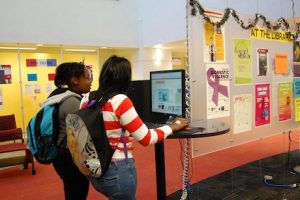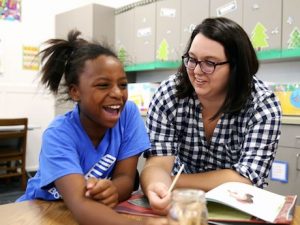When school lets out, nearly 14 million middle and high school students are on their own, according to the Young Adult Library Services Association. With several unsupervised hours at a tween’s or teen’s disposal, it’s easy to see why juvenile crime and experimentation with drugs or alcohol is at its highest between 3 and 6 p.m. on weekdays.
Fortunately, area schools, libraries and community centers have plenty to offer kids of all ages, from Kindergarten through high school, so chances are good you can find a program to keep your kids busy, engaged, and above all, safe.
FIRST THINGS FIRST
First, it helps to know how you want your child spend those hours after school. Working on homework? Playing a sport? Pursuing a favorite activity, like dance or computer coding? Knowing how you want their time spent will point you in the right direction.
Local mom blogger Bonnie Jean Feldkamp says, “We always had one hard fast rule in our house: you’re not just allowed to do nothing. Sure, some days nothing is good and we all need times for a good movie, video game or just reading a good book or doing a jigsaw puzzle. But in my house growing up and also now in my house as a parent, we value volunteering.” She adds that her children have volunteered at their school, the library, and at a local nonprofit horse stable.
WHAT YOUR SCHOOL CAN DO FOR YOU
Most schools offer after-school activities, and that helps parents avoid the transportation issue. Kids participate in everything from sports to homework help. West Chester mom Tina signed up her son for Beta Club at Mother Teresa Elementary (mtces.org), where he attends Kindergarten. “He doesn’t need tutoring, but Mother Teresa had 50-plus eighth graders sign up to tutor, so I figure he can read and write with his tutor, and it’s a good opportunity to have an eighth grade buddy.”
In addition to groups like the glee club, art club, and band, Mother Teresa brings in outside vendors like Webby Dance, Bricks for Kids, and the Better Babysitters Club. Programs are offered in short sessions, according to Kathy Gilkey, Mother Teresa’s Office Manager, giving students a chance to explore multiple activities.
At The Summit Country Day School (summitcds.org), students (and parents) benefit from after-school programming that includes everything from chess, dance, and yoga. “I am the fun!” says Lisa Nicholson, Auxiliary Services Manager, who creates the after school and summer programs at Summit. Currently, programs for kids in Montessori through the first grade include activities like ballet, chess, Bricks for Kids, even a Chinese language class. Different programs are available on different days each week, and last from 3:15 – 4:05 in the afternoon. From there, children can head over to Extended Day where teachers and high school helpers are on the scene to lead them through crafts and games. Middle grade students can take advantage of Homework Start, which is staffed with teachers who help children with homework projects.
“We’ve really learned how many families are dual income,” says Nicholson, adding that it explains the growth in the after school programs’ popularity. Looking to the future, Nicholson hopes to bring in outside companies for more programs for older students who may feel too old for Extended Day, but get their homework done quickly enough that they have free time.
Some schools create partnerships to keep kids busy. The College Conservatory of Music at UC (ccm.uc.edu.prep/programs.html) has teamed up with City Gospel Mission’s Whiz Kids and select schools for an after-school program that matches grades K – 6 with college students studying music, theater and dance. Student Leaders take children through weekly activities that culminate in an “Informance” where kids show off what they learned. Cincinnati Public Schools hosts Community Learning Centers within the district’s school buildings – according to their web site, the CLCs provide after school programs, but also counseling, programs for parents, and career and college services (cps-k12.org/community/clc).
OUTSIDE SCHOOL
Community centers are another valuable tool for families looking for after school solutions. The Boys & Girls Club of Greater Cincinnati (bgcgc.org) currently serves over 5,000 kids in 12 clubs across Greater Cincinnati and Northern Kentucky. The Clubs are designed to provide safe spaces for ages 5 – 18. Kids can get help with homework while developing life skills and spending time with positive role models. Plus, kids enjoy a hot meal, all for free. Clubs are open Monday through Friday, 2:30 – 7:30 p.m. Kids enjoy free time and a snack before diving into a planned program that includes a choice of Graduate (focusing on academic success), Fit For Life, and Ready to Serve (focusing on community service and volunteering).
Other options include the YMCA of Greater Cincinnati (cincinnatiymca.org), the Mayerson JCC (mayersonjcc.org), and the Cincinnati Recreation Commission (cincinnati-oh.gov/recreation).
ON LIBRARIES AND TEENS
Aside from providing materials suited for the YA audience, many libraries have created special areas for tweens and teens to feel welcome.
 “There are few places to go that are free, that have stuff to do, and you can hang out for an unlimited amount of time,” says Lisa Soper, Youth Services and Programming Coordinator for the Public Library of Cincinnati and Hamilton County (cincinnatilibrary.org). With many branches living near schools, libraries see a lot of kids come through their doors, making them an ideal spot for programming and socializing. But how to make them inviting for teens?
“There are few places to go that are free, that have stuff to do, and you can hang out for an unlimited amount of time,” says Lisa Soper, Youth Services and Programming Coordinator for the Public Library of Cincinnati and Hamilton County (cincinnatilibrary.org). With many branches living near schools, libraries see a lot of kids come through their doors, making them an ideal spot for programming and socializing. But how to make them inviting for teens?
Gathering input from teens is what helped to make the Main Library’s TeenSpot a welcoming space, according to manager Jennifer Korn. She explained that in the mid-2000s, libraries that had previously lumped teens in with children began to recognize that teens have their unique needs and wants. As a result of that movement, the TeenSpot was designed with input from a young advisory board – one that continues to provide input on programming and services.
After school programs at the TeenSpot include everything from Wii games, to low-tech arts and crafts activities, and STEM and Maker-inspired happenings. A Homework Help Center is open daily with tutors for middle school students and online tutoring access for high schoolers. It’s a popular spot, according to Korn, who estimates that 40 – 50 kids stop by each day during the school year.
In Northern Kentucky, the Campbell County Public Library (cc-pl.org) has a selection of monthly programs designed by a teen librarian. They range from YA book clubs to art clubs and game nights, as well as a Teen Advisory Board.
Monthly programs at the Boone County Public Library (bcpl.org) range from Anime and Manga clubs, Teen Writer Tuesdays, and Read It First, which allows teens to read books before they are published. Teens can join volunteer programs like Read With a Teen, which trains them to work with younger kids. Says Pamela Jayne, Youth Services Librarian, “By being available to the teens, we hope to engage in open communication to determine what programs and services Boone County Public Library can provide, and empower the teens to give us honest feedback.”
Libraries aren’t just a place to keep teens occupied. Says Erin DeSantis, Young Adult Librarian at Kenton County Public Library (kentonlibrary.org), “Preparing teens for the workforce is a major concern, and our VolunTeen Program has allowed multiple teens to acquire job skills early to prepare for their future. The Covington branch partners with the Housing Authority of Covington each summer for the Teen Summer Work Program by employing a teen to assist in many departments.” She adds that the Erlanger and Durr branches provide teens opportunities to volunteer in the Children’s Department — a great way to put those after-school hours to good use for both big kids and little ones.





